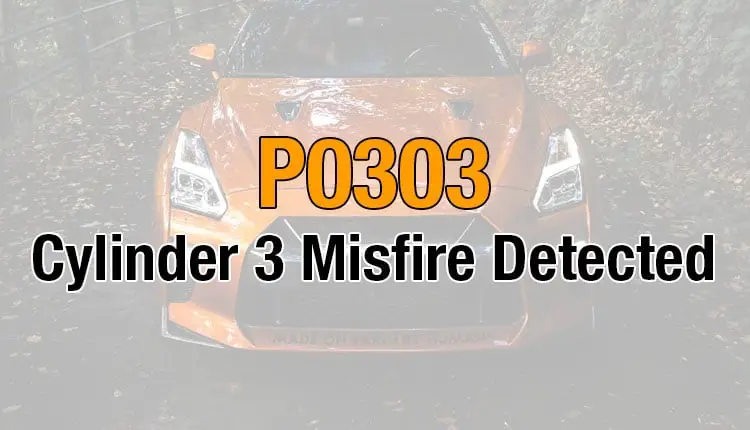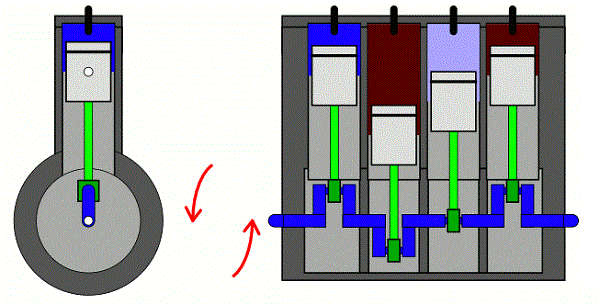P0303 – Cylinder 3 misfire detected
The P0303 code activates whenever cylinder 3 in your engine misfires. While a single misfire may not be cause for concern, repeated misfires are a sign of a bigger problem and could lead to long-term damage.
Finding the source of the misfire isn’t always easy, even when you know which cylinder it’s affecting. If other trouble codes are active, those can be a big help in isolating the issue. If not, there are steps you can follow to correctly diagnose the P0303 OBD2 code.
Diagnosing P0303 can be a time-consuming process. The good news is, it doesn’t always mean an expensive or difficult repair. Read on below to learn more.
P0303 code definition
P0303 code definition (generic): Cylinder #3 misfire detected
P0303 Ford code definition: Cylinder 3 misfire detected
P0303 Nissan code definition: Number 3 cylinder misfire detected
P0303 Subaru code definition: Cylinder 3 misfire detected
P0303 Toyota code definition: Cylinder 3 misfire detected
P0303 VW code definition: Cylinder 3 misfire detected

What does P0303 mean?
The generic powertrain code P0303 tells you there’s been a misfire in cylinder 3. You’ll usually see it along with the broader P0300 OBD2 code, which activates for a random misfire. Other trouble codes might come up, as well, including those relating to the air/fuel mixture.
While this code is generic, the fixes can vary depending on your car’s make and model. Always check your vehicle’s manual for recommended repairs before starting your diagnosis. Check for any technical service bulletins, as well, in case there’s a known issue for your car.
The exact placement of the cylinders in your engine depends on its size and style. In most V8 engines, cylinder 3 is directly behind cylinder 1, on the right side when you’re facing the engine. There are major manufacturers, however—most notably Ford—that number the cylinders from front to back, making cylinder #3 the third one back on the right side. Verify how your cylinders are numbered in your manual before starting your diagnosis.
What are the symptoms of the P0303 code?
If the misfire was a one-off problem, you may not experience any drivability symptoms. In most cases, though, they will be severe. The most common include:
- Activation of the check engine light
- Shaking or rough running from the engine
- The smell of fuel in the exhaust
- Jerking and hesitation when accelerating
- Reduced engine power
- Reduced gas mileage
- Hard starts and stalls

What are the causes of P0303?
The most common causes of the P0303 OBD2 code are:
- Worn or faulty spark plugs
- Worn or faulty wiring around the spark plugs
- Worn or faulty coil packs
- Faulty distributor
- Faulty fuel injector
Cylinder 3 misfires can also be caused by:
- Vacuum leaks in the fuel or exhaust systems
- Faulty camshaft sensor, crankshaft sensor, or oxygen sensor
- Faulty or clogged catalytic converter
- Low fuel pressure
- Low engine compression
- Fuel quality incorrect for the engine
- Faulty computer (rare)
How serious is the P0303 code?
The P0303 trouble code is potentially quite serious. Misfires in the engine can cause damage to internal systems. The erratic driving that’s often a symptom of this trouble code also makes the vehicle unsafe to drive. Avoid driving your vehicle until you’ve repaired the issue.
How to diagnose the P0303 code
Tools you’ll need:
- OBD2 scan tool
- Basic tool kit (a screwdriver, a ratchet set, a socket set, etc.)
- Digital multimeter
- Fuel pressure gauge
- Compression tester
Method:
- Use the OBD2 scan tool to check for other trouble codes. If any others come up, fix those first.
- Clear all codes and test drive your vehicle. If P0303 doesn’t come back and you’re experiencing no symptoms, it may have been a random misfire.
- Inspect all the vacuum hoses in your system for air leaks. Be sure to feel any spots you can’t see for hidden damage or holes.
- Inspect the ignition coils and wiring for damage and ensure the connections are secure. Check the spark plug wires for the same issues.
- If your engine has movable coil packs, swap the cylinder 3 coil pack with the one in cylinder 1. Clear the codes and rescan your vehicle. If the misfire moves, the coil pack is likely faulty.
- Visually inspect the spark plugs. If they’re coated in oil, corroded, or fouled by carbon build-up, clean or replace them.
- Use a digital multimeter to test the spark plug wires. Remove each wire and connect one multimeter lead to each end. Compare the reading with your vehicle’s specifications.
- Check the fuel injectors using a digital multimeter. Inspect the wiring for damage or loose connections.
- Use a fuel pressure gauge to check your fuel pressure. If it’s too low, either the fuel pressure regulator or the fuel pump is failing.
- Perform a compression test to check for mechanical causes of the misfire, like a burned valve or worn valve guide. This test will also tell you if the engine timing is off due to a skipped or misaligned timing chain.
Common mistakes to avoid while diagnosing the P0303 code
Many people start replacing big components before they check the little things like leaking hoses or damaged wires. Be thorough in your diagnosis so you don’t overlook potentially cheap and easy solutions.
What should you do to fix the code P0303?
- Replace any damaged wires found during your diagnosis. If you located more than 2 bad wires around the spark plugs, it’s recommended to replace the entire set.
- Repair or replace any leaking hoses or other sources of air leaks in the air intake system.
- If the coil pack failed or the spark plugs were fouled, replace them.
- Replace any fuel injectors that failed step 8 of the diagnosis. If your fuel pressure is still too low, replace your fuel pump.
Tips to avoid P0303 in the future
Problems with the air-to-fuel ratio often lead to misfires. Leaks in the vacuum system make the mix too lean. Inspect your vacuum hoses periodically for leaks and ensure they’re fastened securely, away from any engine components that could cause damage.
Read more:
